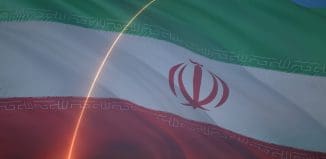The Iranian Nuclear Secret: A Plutonium-Based Atom Bomb
This post is also available in:  עברית (Hebrew)
עברית (Hebrew)
By Ami Dor-On
 The Iranian nuclear reactor in Arak, already operating under the code name IR-40, is capable of producing 10-12 kilograms of plutonium a year. 6-10 kilograms are needed to produce one atom bomb. This means that Iran will have enough plutonium to manufacture a nuclear weapon by June 2014. Iran doesn’t allow International Atomic Energy Agency inspectors access to the Arak reactor, nor access to the active heavy water facility it had built next to the reactor, which is fueled by natural uranium. According to western intelligence estimates Iran’s strategic goal isn’t the destruction of Israel; Iran plans to take over the oil-producing states: Saudi Arabia, Iraq and the Persian Gulf emirates. The Iranian leaders believe that if they’ll become a nuclear superpower and gain control over all Middle-Eastern oil resources, Iran won’t be “just another state” anymore – it will become a global Islamic empire.
The Iranian nuclear reactor in Arak, already operating under the code name IR-40, is capable of producing 10-12 kilograms of plutonium a year. 6-10 kilograms are needed to produce one atom bomb. This means that Iran will have enough plutonium to manufacture a nuclear weapon by June 2014. Iran doesn’t allow International Atomic Energy Agency inspectors access to the Arak reactor, nor access to the active heavy water facility it had built next to the reactor, which is fueled by natural uranium. According to western intelligence estimates Iran’s strategic goal isn’t the destruction of Israel; Iran plans to take over the oil-producing states: Saudi Arabia, Iraq and the Persian Gulf emirates. The Iranian leaders believe that if they’ll become a nuclear superpower and gain control over all Middle-Eastern oil resources, Iran won’t be “just another state” anymore – it will become a global Islamic empire.
After Iranian President Hassan Rouhani spoke at the U.N. General Assembly, it seemed that his friendly and placating facade convinced many western leaders, U.S. President Barack Obama among them, that the impossible is finally happening: Iran is willing to seriously discuss its uranium enrichment operations, which will eventually lead to the development of nuclear weapons. Sadly, Iran once again successfully deceived the west, this time under a new, more presidential leadership.
Talks with Iran are still ongoing, supposedly progressing towards some sort of “understanding”, but the Iranian leadership – in secrecy and while preventing any international oversight – manufactures plutonium-based nuclear weapons in the Arak reactor. Arak is situated in north-western Iran, about 260 kilometers from Tehran, and the reactor, active since June 2013, already produces 40 megawatts.
A short scientific explanation is required to understand exactly what’s at stake. Plutonium is a metallic, highly radioactive artificial element, its symbol is Pu and its atomic number 94. In nature it can be found only in miniscule amounts, but never as an ore like uranium. It’s a byproduct of the fission processes in nuclear reactors cooled by heavy water systems. It’s highly radioactive and dangerous, and inhaling or swallowing more than a millionth of a gram can cause cancer or death. The vast majority of plutonium on Earth is man-made. It was first discovered in 1941, as a lab byproduct in the UC Berkeley particle accelerator. Nuclear researchers, headed by chemistry Nobel Prize winner Glenn Theodore Seaborg, bombarded uranium 238 with deuterium 1. This bombardment resulted in an unstable material called neptunium 238, with a half life of 2.1 days. A few days later the neptunium deteriorated and became plutonium, which can be used to achieve chain reactions in nuclear weapons.
Iran has wanted Plutonium for nuclear weapons for some time now. For a few years Iran tried to purchase the dangerous element covertly from various sources, especially from the former soviet union member states. Western intelligence agencies exposed several of these failed attempts. Having failed to purchase plutonium on the “black market”, the Iranians decided to build a heavy water facility for their own use. Iran does not allow IAEA (International Atomic Energy Agency) inspectors to visit the Arak reactor, and also bans visits to the heavy water production facility, which is located next to the reactor itself, fueled by natural uranium. Their reason for refusing to cooperate with the IAEA is simple. According to international treaties a reactor fueled by natural uranium doesn’t have to be subject to IAEA inspections. This fact helps Iran hide its practical use of the Arak reactor, also known as IR-40. When operating at full capacity the reactor can manufacture 10-12 kilograms of plutonium a year. It takes 6-10 kilograms to create one atom bomb. These numbers mean that Iran will have enough plutonium for a bomb in June 2014.
iHLS – Israel Homeland Security
The Iranian-made Arak reactor reflects the very advanced capabilities of the Islamic republic in this area, even though many of the materials and technologies it required were either stolen or purchased, using covert procurement networks operated by the Iranian Ministry of Intelligence and straw companies established by the Revolutionary Guard. One of the problems facing those who intend to operate a nuclear reactor in order to produce plutonium is obtaining heavy water. It turns out, however, that the production of heavy water is a relatively simple process, similar to producing ammonia, alcohol and more, materials whose production processes are already known to the Iranian regime. Heavy water can also be produced using regular water. Heavy water is produced in several countries around the world, such as Argentina, Canada, India and Norway. Canada is the world leader in heavy water production.
The London Telegraph recently published a report on the Iranian “plutonium option”, including satellite imagery commissioned by the IAEA. According to the report the steam column rising above the reactor is indicative of heavy water production, and this demonstrates the fact that the Iranian regime has more than one way to manufacture nuclear weapons. According to IAEA experts the Arak imagery reflect Iran’s progress in building plutonium-producing facilities, as an alternative to the development of uranium-based nuclear weapons.
A nuclear bomb’s most dangerous attribute isn’t the massive blasts nor the extreme temperatures at the blast center, it’s the radiation itself. The radiation rises into the atmosphere and gets carried over thousands of kilometers by winds and clouds, eventually reaching the surface along with the rain. Radioactive rain waters reach the human body, entering it through drinking water and natural foods. Radiation lasts for many years, and above a certain level can be extremely lethal, turning entire areas to lifeless wastelands. Radiation victims suffer from bone cancer, liver deterioration or blood cell destruction. Most become sterile, their cells suffering from hereditary transformations and some of their descendants born with debilitating mutations.
A plutonium bomb isn’t a new invention. Such a bomb was used for the first time in history at the end of World War II, when the American Air Force dropped one on the Japanese city of Nagasaki on August 9th, 1945. The bomb, nicknamed Fat Man, caused the death of 40,000 people and left tens of thousands suffering from radiation sickness.
One of the main issues the international community is dealing with these days is what, exactly, does Iran hope to gain by developing nuclear weapons and by funding global terror, a policy which at first glance seems completely irrational and dangerous for Iran itself. Above all, the question is why do they target Israel with their propaganda, when most agree that Israel is no threat to Iran’s existence. According to the world powers’ intelligence estimates Iran’s strategic goal isn’t the destruction of Israel – Iran wants to take over the oil producing states: Saudi Arabia, Iraq and the Persian Gulf emirates.
The Iranian leaders believe that if they’ll become a nuclear superpower and gain control over all the oil sources in the Middle East, they’ll no longer be considered “just another state”. Iran, according to them, will become global Islamic empire. Iran’s leaders already made some public declarations that shed light on these imperial aspirations. According to these declarations the scientific infrastructure of the Arak reactor will also be used to develop the new, 336 megawatt reactor which is being built in the Darkhovin site, close to the city of Ahvaz. This reactor, with a capacity ten times that of the Arak reactor, can produce 100-120 kilograms of plutonium a year – meaning it can also produce ten times as many atom bombs.




























